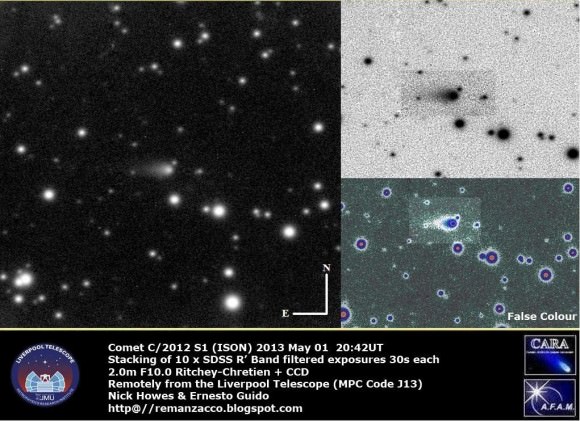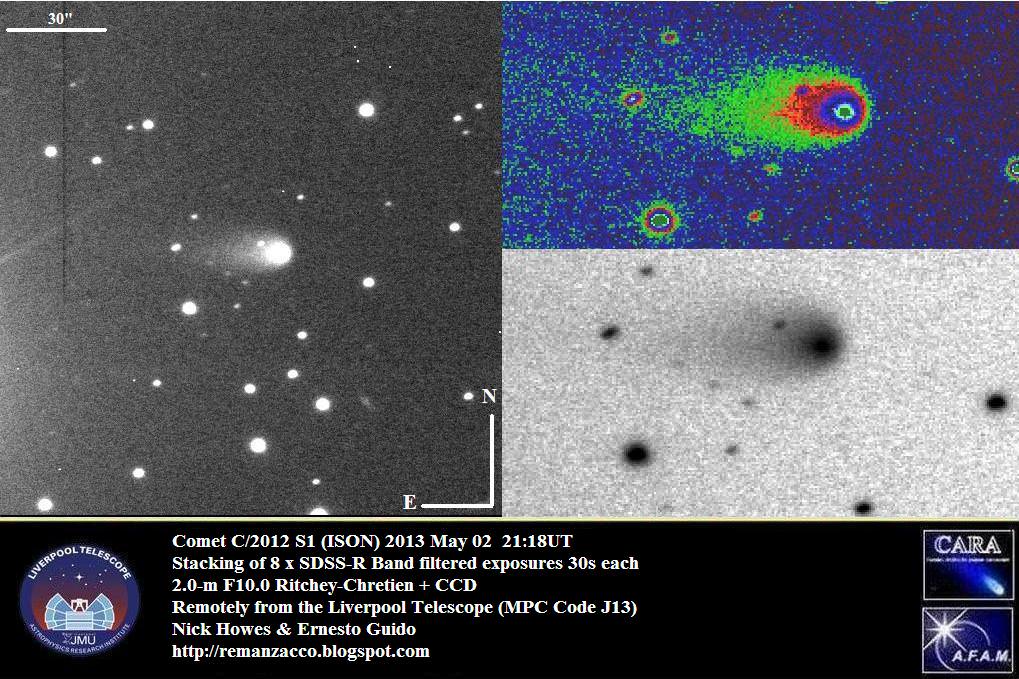Update: Here’s a brand new image of Comet C/2012 S1 ISON, as seen on May 2, 2013 by Ernesto Guido and Nick Howes of the Remanzacco Observatory (their image from May 1, which we featured earlier, is below.) For this latest image, they used the 2-meter Ritchey-Chretien Liverpool Telescope. Via Facebook, Howes said they have been able to identify almost the same tail structure which was seen in the Hubble Space Telescope images of this comet from April 10.
From the May 1 observations, their initial approximation of the tail length is around 28 arcseconds, which Howes told Universe Today is bigger than some recent reports from smaller scopes.
Below is their image from May 1, using the 2 meter La Palma Telescope:

As of May 2, Comet ISON was approximately 3.885 AU from the Sun, which is about 581 million kilometers (361 million miles) distant from the Sun. ISON will makes its close approach to the Sun when it passes within 1.2 million km (730,000 miles) of the Sun on November 28, 2013.
Here’s a video from NASA about this comet’s path through the Solar System:


I like studying on comets. I have read al of news that related
it looks like comet ISON will have an extremely close approach to Mars as well, maybe curiosity can snap some images??
Curiosity’s cameras are not designed to be able to look “up” and capture anything that distant. They were designed to be used on the surface of Mars. Too bad…good suggestion.
Yes… Curiosity WILL take a look at Comet ISON. It will also take a look at Comet 2013 A1 when it makes a CLOSE passage by Mars… Curiosity’s Mastcam is called the Mastcam because it is mounted on the end of a very mobile robotic arm/mast which can point at almost any angle…
The question of the day: Is this the same “Firey” comet that appeared in 1680 (Newton’s Comet), 1347 (Comet Negra), 1014 and 678AD (All approximately 333 years apart and along the same generral path)? Or do they stem from a common source. S
Maybe you should first prove that they came from the general path and thus have the same orbital elements and move in the same direction..
Hope to see this pup… It will be #47 for me! (Thank you #46 aka Comet PanStars! It seemed like I was stuck on #45 for the longest time!)
I modified the above NASA video to include ISON’s path against the constellations. It was a lot of work, but hope you all enjoy it. http://www.youtube.com/watch?v=fgrQLF8OhvU
Built a site entirely dedicated to comets, including ISON, at http://www.fallofathousandsuns.com/comets.html.
I Love Joy ….. Joy loves Sol and we live happily ever after…..
can it be seen with a telescope? tonight? may 12 2013 est? central florida? i once tracked an object posibly a asteroid by accident was so excited it was moving very slow compared to the background stars so i gueesed it was really far .. i always end up seeing things like that even when i just look up randomly. sometimes i feel like im the one being watched